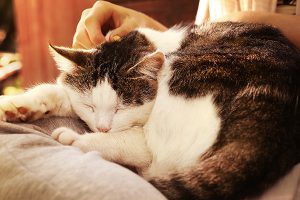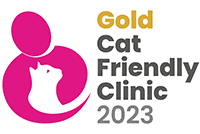Hyperthyroidism (overactive thyroid) is one of the commonest conditions seen in older cats and is caused by the production of too much thyroid hormone by the thyroid glands in your cat’s neck. It can cause severe illness and the initial symptoms can be very subtle, but thankfully, once diagnosed, most cats do very well with the correct treatment.
Thyroid hormone controls many functions in the body, but is mainly responsible for the metabolic rate. When too much hormone is produced, the body requires much more energy.
The commonest symptom is weight loss despite a good or even increased appetite. Often there are some subtle behaviour changes, such as restlessness and irritability and usually there is an increased thirst. Vomiting and diarrhoea are common as is a poor hair coat. It is important to remember that older cats can have more than one condition and kidney disease is often seen alongside hyperthyroidism. Importantly, it causes an increase in heart rate and changes to the heart muscle which can lead to heart failure if left untreated.
Nobody fully understands the causes of hyperthyroidism, but most cases have a benign (non-cancerous) increase in size of one or both thyroid glands which means excessive hormone is produced. A very small number of cases have a malignant change.
Diagnosis is usually via simple blood tests and there are multiple treatment options available.
Hypothyroidism (underactive thyroid) in cats is very rare. You cat will become less active and noticeably gain weight. This is because the opposite is happening and there is a decrease in hormone production. Treatment involves synthetically replacing this hormone to restore the balance.
If you think your cat might be showing signs of hyperthyroidism (or hypothyroidism) please contact your local Village Vet practice and book an appointment with your vet.












